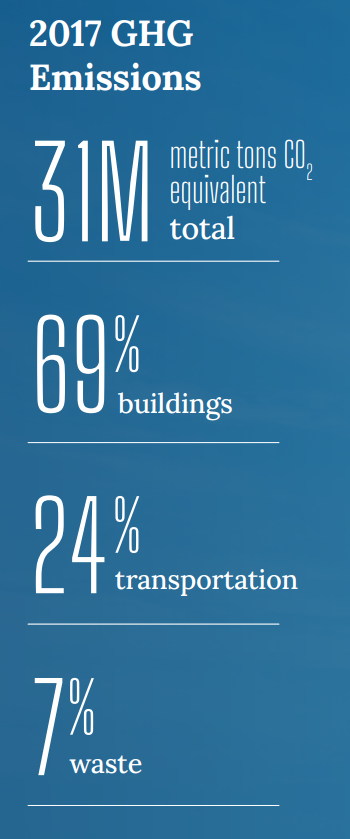Electrify Chicago
An independent tool for viewing City of Chicago building data
According to the
2022 Chicago Climate Action Plan,
69% of Chicago's emissions come from buildings, making
building emissions our biggest challenge and our biggest opportunity as a city
to tackle climate change. At Electrify Chicago, we showcase building performance using
publicly available data supplemented by community-submitted photographs and building
owners.
Start by looking at Chicago's buildings with the highest greenhouse gas intensity i.e. emissions per square foot. Large, efficient, buildings can perform much better than very inefficient small buildings on this metric.
New Article
📰 $30 Million In Missed Fines
The City Of Chicago failed to collect $30 million in potential fines from the building benchmarking ordinance, reducing transparency and accountability.
Legislative update! 🎉
As of late January 2024, legislation is being introduced to require new use more efficient forms of water and space heating, via the Clean And Affordable Buildings Ordinance (CABO), which will reduce the number of highly polluting and inefficient buildings that end up on this site.
If you're in Chicago,
write to your alderman to support the CABO!
Chicago Buildings by Greenhouse Gas Intensity
Note: Data includes large Chicago buildings with data from 2022, unless explicitly stated otherwise.
Note: This data only includes buildings whose emissions are reported
under the
Chicago Energy Benchmarking Ordinance. According to the City “As of 2016,
this list includes all commercial, institutional, and residential buildings larger than
50,000 square feet.” This dataset is also then filtered to only buildings with
reported emissions > 1,000 metric tons CO2 equivalent.
The latest year of data is from 2022, but we update the site regularly when new data is available, and some buildings may have failed to report that year, and only have older data available.
| Property Name / address | Primary Property Type |
Greenhouse Gas Intensity (kg CO2 eq./sqft) |
Total Greenhouse Emissions (metric tons CO2 eq.) |
|---|---|---|---|
|
5000 Marine Drive Corporation: The Aquitania
5000 N Marine Dr
| Multifamily Housing | 4.4 kg/sqft
Lowest 15%
| 670 tons
Lowest 38%
|
|
Yates -CPS
🕰️
(CPS)
1839 N Richmond St
| K-12 School | 4.4 kg/sqft | 643 tons |
|
Lawndale Community Academy -CPS
🕰️
(CPS)
3500 W Douglas Blvd
| K-12 School | 4.4 kg/sqft | 513 tons |
|
Seward Communication Arts Academy -CPS
(CPS)
4600 S Hermitage Ave
| K-12 School | 4.4 kg/sqft
Lowest 15%
| 435 tons
Lowest 20%
|
|
Pickard Elementary, Josiah L -CPS
🕰️
(CPS)
2301 W 21st Pl
| K-12 School | 4.4 kg/sqft | 512 tons |
|
Armour Elementary -CPS
(CPS)
950 W 33rd Pl
| K-12 School | 4.4 kg/sqft
Lowest 15%
| 366 tons
Lowest 14%
|
|
212 East Condominium
212 E Cullerton St
| Multifamily Housing | 4.4 kg/sqft
Lowest 15%
| 660 tons
Lowest 38%
|
|
James Kilmer Condo Association
1560 N Sandburg Ter
| Multifamily Housing | 4.4 kg/sqft
Lowest 15%
| 3,282 tons
Highest 12%
|
|
535 North Michigan
535 N Michigan Ave
| Multifamily Housing | 4.4 kg/sqft
Lowest 15%
| 1,983 tons
Highest 23%
|
|
Museum Park Lofts
125 E 13th St
| Multifamily Housing | 4.4 kg/sqft
Lowest 15%
| 918 tons
Highest 48%
|
|
201 211 E 31ST ST
201 211 E 31ST ST
| Multifamily Housing | 4.4 kg/sqft
Lowest 15%
| 224 tons
Lowest 3%
|
|
2900 2914 N MILDRED AVE
2900 2914 N MILDRED AVE
| Multifamily Housing | 4.4 kg/sqft
Lowest 15%
| 274 tons
Lowest 6%
|
|
5000 S CORNELL AVE
5000 S CORNELL AVE
| Multifamily Housing | 4.4 kg/sqft
Lowest 15%
| 655 tons
Lowest 37%
|
|
1155 West Armitage Condominium Association
1153 1155 W ARMITAGE AVE
| Multifamily Housing | 4.4 kg/sqft
Lowest 15%
| 328 tons
Lowest 10%
|
|
1422 1424 W 47TH ST
1422 1424 W 47TH ST
| Strip Mall | 4.4 kg/sqft
Lowest 15%
| 323 tons
Lowest 10%
|
Data Source:
Chicago Energy Benchmarking Data
